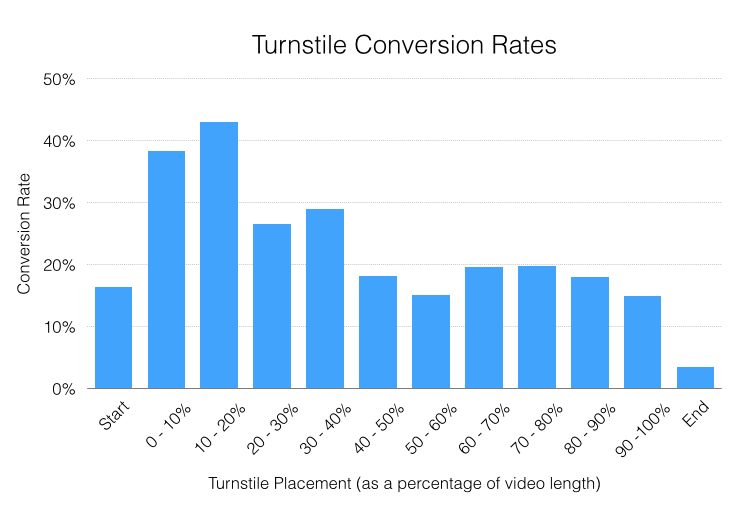
Impact of Video Conversion Rate in the Digital Realm
Understanding and interpreting video conversion rates in digital marketing requires a nuanced approach. Marketers must consider factors such as aligning metrics with brand objectives, the dynamic nature of audience behavior, impacts of algorithmic changes, adherence to platform policies, and adaptability to industry trends. A proactive and continuous learning mindset, along with building resilient strategies, is crucial for optimizing the impact of video content in the ever-evolving digital landscape.
Decoding Video Conversion Rate:
Video performance metrics are key performance indicator (KPIs) that measures the percentage of viewers who take a desired action after watching a video. This action can vary based on the goals of the marketing campaign and may include clicking a link, filling out a form, making a purchase, or any other predefined objective.
The formula for calculating the video conversion rate is straightforward:
Video Conversion Rate=(Number of Video Views/Number of Conversions)×100
Understanding this metric provides insights into the effectiveness of a video in compelling viewers to move through the sales or engagement funnel.
“Successfully navigating the landscape of video performance metrics involves not just decoding the numbers but understanding the dynamic interplay of audience behavior, platform changes, and overarching campaign goals.”
-Ellen Aison

Influencing Factors on Video Performance Metrics:
Several factors contribute to the success or challenges of video performance metrics. Recognizing these elements is crucial for devising strategies that maximize the impact of video content.
- Content Relevance:
Engaging Content: The relevance and quality of the video content play a pivotal role. Compelling and informative videos are more likely to keep viewers engaged and encourage them to take the desired action.
Alignment with Audience Needs: Understanding the target audience and creating content that resonates with their needs, interests, and pain points is foundational to high conversion rates.
- Call-to-Action (CTA):
Clear and Compelling: The CTA within the video should be clear, compelling, and aligned with the video’s objective. Ambiguity in the CTA can lead to viewer confusion and reduced conversion rates.
Strategic Placement: The timing and placement of the CTA within the video can impact conversions. It should appear at a point where the viewer is sufficiently engaged and motivated to take action.
- Video Length and Format:
Optimal Duration: The length of the video matters. Viewers may lose interest in lengthy content, impacting conversion rates. Finding the optimal duration that delivers the message effectively is essential.
Mobile Optimization: With the rise of mobile viewership, ensuring that videos are optimized for various devices and screen sizes is imperative for maximizing conversions.
- Loading Time:
Quick Loading: Slow-loading videos can lead to viewer abandonment. Optimizing video loading times enhances the overall user experience, positively influencing conversion rates.
- Landing Page Experience:
Alignment with Video Content: When a viewer clicks on a CTA, the landing page should seamlessly continue the narrative from the video. Consistency in messaging and design fosters trust and encourages conversions.
Simplified Forms: If the conversion involves a form, keeping it concise and user-friendly contributes to higher completion rates.

Strategies to Enhance Video Performance Metrics:
- A/B Testing:
Conducting A/B tests on various elements, such as thumbnails, video titles, or CTAs, helps identify the most effective components for driving conversions.
- Personalization:
Tailoring videos to specific audience segments or even individuals can significantly increase relevance and engagement, ultimately impacting conversion rates positively.
- Analytics Utilization:
Leveraging analytics tools provides valuable insights into viewer behavior. Understanding where viewers drop off or rewatch portions helps refine content for better conversion outcomes.
- Email Marketing Integration:
Incorporating video content into email marketing campaigns can boost engagement. Including a video thumbnail linked to the full video within emails can entice recipients to click and convert.
- Interactive Elements:
Incorporating interactive elements, such as clickable annotations or in-video quizzes, can enhance viewer engagement and drive them towards the desired action.
The Future Landscape:
As technology continues to advance, the future of video performance metrics holds exciting prospects. Innovations like interactive videos, shoppable content, and augmented reality are shaping the next frontier. Adapting strategies to incorporate emerging metrics ensures businesses stay ahead in the ever-evolving landscape of video marketing.
Challenges and Considerations:
While video performance metrics offer a wealth of insights, interpreting them requires a nuanced understanding of the brand’s goals and audience behavior. Additionally, external factors, such as changes in algorithms or platform policies, can impact metric interpretation. Staying informed and adaptable is crucial to overcoming these challenges.
Nuanced Understanding for Interpretation:
Interpreting video performance metrics goes beyond the surface numbers. It necessitates a nuanced understanding of the brand’s overarching goals, the intricacies of audience behavior, and the context in which the video is presented. A holistic comprehension allows marketers to glean meaningful insights from the metrics.
Alignment with Brand Objectives:
Each brand has unique objectives tied to its marketing initiatives. Video performance metrics should not be viewed in isolation but rather in alignment with broader business goals. Whether the aim is to drive sales, increase brand awareness, or foster engagement, understanding how video content contributes to these objectives is essential.
Dynamic Nature of Audience Behavior:
Audience behavior is inherently dynamic, and influenced by various factors such as trends, preferences, and external events. Marketers need to adapt their interpretation of video performance metrics based on the evolving nature of how audiences engage with content. Regular analysis and adjustments are crucial for staying attuned to shifting behaviors.
Impact of Algorithmic Changes:
Digital platforms frequently update their algorithms and policies, impacting the visibility and reach of video content. Marketers should be vigilant about changes on platforms where their content is hosted, as alterations in algorithms can significantly influence how videos are surfaced to the audience. This dynamic landscape requires an agile response to maintain optimal performance.
Navigating Platform Policies:
Platform policies dictate the rules and regulations governing content dissemination. Changes in these policies can directly impact the strategies deployed for video marketing. A thorough understanding of platform guidelines is necessary to ensure compliance and to adjust content and strategies accordingly.
Optimizing video performance metrics is not a one-size-fits-all endeavor. It demands a strategic approach that considers the unique aspects of the brand, target audience, and campaign objectives. By continuously refining content, testing strategies, and staying attuned to evolving trends, businesses can harness the power of video content to drive meaningful conversions and achieve their marketing goals.




